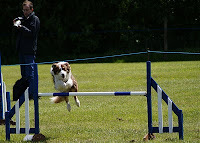 |
| Photo Courtesy of mister b 1138 |
AKC
USDAA
The USDAA stands for the United States Dog Agility Association, Inc , formed in 1986. The organization was created using British standards including equipment used and the rules and regulations for the standard agility course. It also introduced non-standard classes like Jumpers, Gamblers, Snooker, and the Relay. The USDAA is responsible for the following agility tournaments: USDAA's Grand Prix of Dog Agility® World Championships, now in its 17th year, the $10,000 Dog Agility Steeplechase®, and the Dog Agility Masters® Three-Dog Team Championship. These trials tend to be more difficult with narrower planks, higher jumps and larger courses. More emphasis is placed on speed in these trials. The USDAA provides trials for purebred as well as mixed breed dogs. This organization decided to do away with the single ribbon system and devised an agility title system where handlers and their dogs earn points towards different titles. This concept is now extremely popular in the world of dog agility.
CPECPE stands for Canine Performance Events, Inc, a national dog agility association in the US. It allows both purebreeds and mixed breeds to compete in various agility trials. CPE agility trials are similar in style to those sanctioned by the AKC. This association emphasizes fun while trialing and offers many games as classes like Jumpers and Snooker.
 |
| Photo Courtesy of mister b 1138 |
This organization, known as the North American Dog Agility Council, made a bold move by moving away from international standards of dog agility in order to create its own version of a faster, yet safer agility course with less obstacles and lower jump heights. Both mixed breeds and purebred dogs are permitted to compete in the agility trials.
UKC
The United Kennel Club (UKC) formed in 1898 as another purebred dog registry. However, the UKC is different from the AKC because it primarily focuses on working breed dogs and recognizes them for their working abilities in addition to how well they meet their breed’s standards. However, the UKC allows mixed breed dogs to register under the Limited Privilege category which permits them to participate in UKC dog obedience and agility events. They generally have smaller, more contained courses that require more precision.
UK Agility International (UKI)
Existing since 2004 in Great Britain as UK Agility, this organization was urged to spread to North America. They changed the name to UK Agility International and now offer many agility competitions in the U.S and Canada. The organization was formed by a husband and wife team.













